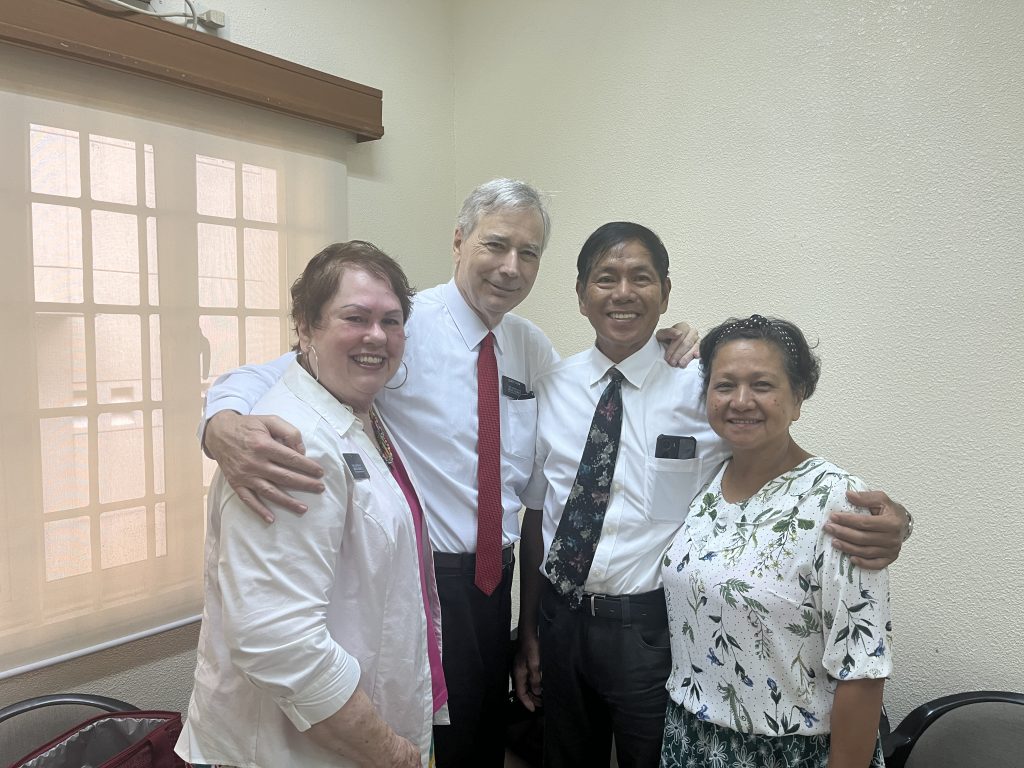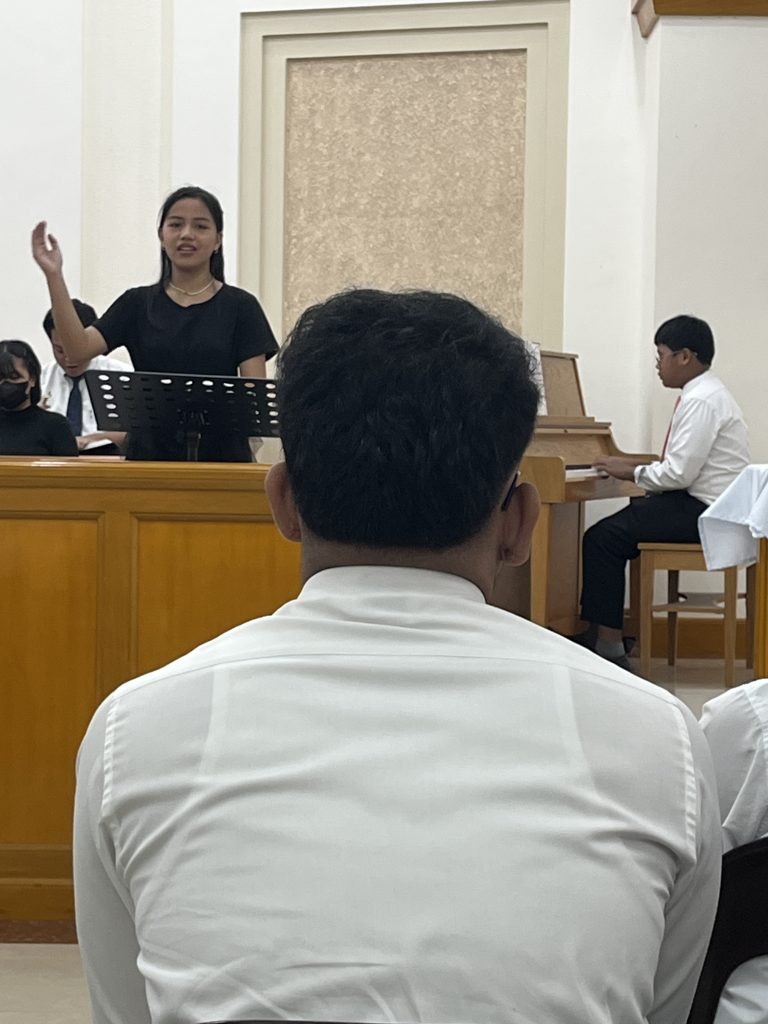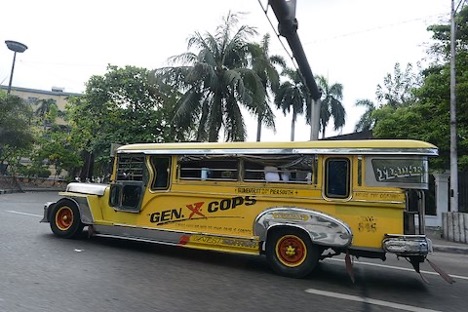A few weeks ago, we took a four-day trip to the provinces (Filipinos refer to the rural areas of their country as the providences) northwest of Quezon City. On this trip, we spent a day and a half in the cities of Tarlac and Angeles (both in the Pampanga providence) in meetings. After these meetings, we drove to Balanga and Hermosa (both in the Bataan providence) ). There we had the privilege to interview two couples and a widowed sister that were among some of the first Filipinos saints to join the Church in the Bataan providence.
One of these interviews was with Brother and Sister Samson. Sister Samson was introduced to the gospel by her sister. She was baptized when she was 16 years old. Her sister paved the way for her parents allowing her to be baptized. A bit of background.
When her sister accepted the gospel, after she had been taught by the missionaries, she asked for permission from her parents to be baptized. Her father refused to give his consent. It took years before her parents eventually allowed her sister to be baptized and this was only because her parents saw the dramatic impact the gospel had in her life. When Sister Samson asked her parents for permission to be baptized, they gave their consent solely based on how the gospel had changed her sister’s life.
After being baptism and graduating from high school, Sister Samson attended a university in Manila studying optometry for two years. After meeting her husband, who was in his mid-twenties, at a dance for young adults, her educational plans changed when they married. Marriage brought about their move back to the Bataan providence. They started their family shortly after getting settled into their new home.
Brother Samson’s first job was as a Tricycle driver. After a few years, he was accepted as maintenance tech for the Church maintaining buildings in this part of the Philippines. Since brother Samson was relatively artistic, he started a side-gig of painting portraits.
Sister Samson was a stay-at-home mom and since she was relatively entrepreneurial, she used some of her husband’s artistic designs he had sketched as templates to create unique embroidery items. She entered these designs in the Church’s annual worldwide art contest five times winning the competition in her category three times in these five years.
Based on these awards, the word began to spread and her embroidered designs began to gain significant notoriety. Over the years, she has built a thriving business employing up to ten people to embroider various items based on the designs that her husband creates.
Before we began our interview of the Samson’s, Sister Samson presented each of us a temple pouch envelope with an embroidered design of the Manila Temple on the front of it. This gester is very typical of the generosity of the Filipino people.
After leaving his maintenance position, Brother Samson started an air conditioning repair and maintenance business. This business is doing exceptionally well. His wife continues to run her embroidering business. They attribute most of what they have accomplished in their life to their Church experience in leadership roles they have held over the years and to the gospel principles they have remained true to over the years.
About Brother Samson
Brother Samson was not a member of the Church when they were married. After a few years, he began taking the missionary lessons and eventually was baptized. Shortly after his baptism, he was made the Sunday school president and then the first branch president of the Balanga branch in Bataan. Two years later he was called as a second counselor in the district presidency. A few years after this calling, he was called to be the district president and then as a counselor in Olongapo Mission Presidency.
At the time of this calling as a counselor in the mission presidency, he was living in Hermosa, Bataan. Hermosa is a two- or three-hour drive (one way) to the City of Olongapo where the mission offices are located. He drove from Hermosa to Olongapo nearly every weekend for seven years. During this time, their family grew to three children. His wife and kids accompanied him many of the weekends he made the journey from Hermosa to Olongapo. After seven years in this calling, he was called as a district president again, a calling he held for the next ten years. He is now serving as a patriarch of the Balanga Stake.
As I listened to the Samson’s story, I thought how a small group of saints in Balanga, and later in Hermosa, became the foundation of what is now tens of thousands of members, multi-stakes, and several missions in Central Bataan. These Filipino pioneer saints possessed incredible faith and dedication encompassing a lifetime of faithful service to the Lord. During all the years and through difficult and challenging times, they never hesitated or flinched, always holding fast to the iron rod as they served the Lord.
As the interview ended, as is so often the case, I felt humbled and unworthy to be in the presence of people like these saints. As I mentioned before, this humbling feeling is becoming a reoccurring theme as we record the oral histories of these faithful Filipino saints. They are truly the cream of the crop and I believe were prepared before the foundations of this earth to be born in this time and place to accept and build up the gospel in the Philippines. These types of inspirational experiences leave us truly all amazed and in opened-mouthed awe.

The Samson’s – I’m Always Amazed at How Young Filipino’s Look – they are in their late-60s.
The Philippines – A Hot Bed of Innovation in the Church.
In a recent meeting with the Temporal Affairs Director for the Philippines (this is the equivalent to the Presiding Bishopric in the US), Brother Ed Fernando, referred affectionally locally as Sir Ed, presided over this meeting. He shared some of the initiatives that are currently going on the Philippines and most of which are under the radar and other under consideration and in the planning stage. When I attend meetings like these, I am impressed at the talent of the Filipino saints – most of which began when these men and women were called to serve as young missionaries, then ever escalating responsible calling of leadership. This type of home grown leadership talent bode well for the future of the Church in the Philippines.
One of the themes of this meeting was sustainability, something I really didn’t expect to be a topic in the Philippines. Stupid me. There was a lot of discussion of our custodianship of mother earth and its resources and what the Philippines Area needed to do to support the global initiatives of the Church on this issue. I was unaware of the existence of this initiative and that this was a thing in the Church. I continue to be amazed at some of the forward thinking in the Church. Some of the initiatives being implemented in the Philippines Area is some straightforward things such as the installation recycle bins for plastics in the area office and other buildings throughout the Philippines, a discussion on feasibility study under discussion on the advisability of putting solar on church buildings, and general discussion on feedback loop to capture ideas and the adoption of the phrase “See Something, Say Something.”
There was a question-and-answer session where various questions related to policy and procedures, etc., were discussed. Several things I learned from this Q&A session is that the My Plan, a three-day intensive life and goal setting and planning session after a missionary is released, is being piloted in the Philippines. No other countries globally have this initiative. I thought it was cool that the Philippines are a pilot. The previously mentioned blog post outlined some of the responsibilities of the Leader and Member Support team that was put in place a few months ago is also a pilot and is only being done in the Philippines. All other support worldwide is provided from Salt Lake City. I have concluded that the reason the Philippines is chosen for some of these pilot programs is because of the depth and quality of leadership in the country.
The meeting concluded with a discussion on the North Star and how it was used in past centuries to navigate maritimers and how we all need to have our own North Star centered on the teaching of Christ. The closing remarks were about being a wise steward of all of the Lord’s resources in our lives.
I left the meeting impressed with how local leadership, at least at this level, really has their act together and is being very proactive.
Filipinos Love Music
I’ve come to appreciate how much Filipinos love music of all genres. We attend church in a completely speaking Tagalog Ward (Pasig 2nd Ward). Although we don’t understand much and what we do understand generally comes from when scriptures or General Conference talks are read in English during Priesthood, Relief Society, or Sunday School Classes. All hymns are also sung in English. So, we do get a general sense of what is being said.
The youth play an important role in this love of music and are actively engaged in participating in the music in church. Below is a picture of a young lady, probably 15-16 years old leading music in Sacrament Meeting. You’ll also notice the young man, in the same general age range, playing the piano.

Youth take the lead in music in the
Pasig 2nd Ward
Things we continue to learn in the Philippines...
More on Christmas
I’m still trying to get use to Christmas songs being played everywhere – at outdoor venues, our apartment building lobby, and sung as hymns in church since the first week of September. Also, it is strange that during the first week of October to have Halloween (yes, this is celebrated here too) decorations up in the lobby of our building with Christmas being played over the overhead speakers in the lobby.


It is just strange to walk through the lobby and see the Halloween decorations of which the above are just two of many all over the place with “Oh, Little town of Bethlehem” playing in the background…this creates Cognitive Dissonance that my mind has a hard time processing.
Time and Schedules in the Philippines
In some of the providences where we have traveled during our mission, we have learned that the rural areas don’t strictly follow time schedules in the conventional sense.
Many people living in the providences don’t use watches and clocks, yet they seem to always know the time. For these people, everything is scheduled around morning, noon, and night.
In talking to some Filipinos about the concept of time and schedules, this is what some have shared with me.
It is more common in rural places (referred to as the providences) and in most of the remote sleepy towns in the Philippines to not worry too much about being on time. For example, in a small town in Northern Luzon you can hear the church bells on the PA system wherever you are in town. Most people (and some businesses) base their schedules on the morning prayer, noontime prayer, early afternoon prayer, etc. Strict schedules don’t make much sense when you’re in a sleepy town in some of the rural areas of the Philippines. There’s no need to rush. It makes more sense just to start working at sunrise, rest when it gets too hot (noontime), and stop working when it gets too dark. Another reason why schedules don’t make sense in the Philippines is the public transport system is very laid back with the main means of transport are Jeepneys and tricycles which are on demand. A Jeepney doesn’t keep a fixed schedule and leaves when it is full. For this reason, Jeepneys don’t have timetables because they only make a profit when they’re full.
In small towns, if you need to go to the market or another city, you go to the transportation terminal and pray that when you get there the Jeepney is almost full and about to leave. Otherwise, you wait.
If you find a mostly empty jeep, you can always eat, nap, read, check your phone, etc., while waiting. Patience is needed because it can take a lot of time if there aren’t enough passengers.
The closer you get to the city, the time schedules are more likely to be followed. If you live in Manila and commute, you likely know the MRT schedule by heart. There are buses round the clock. And traffic apps are good at estimating ETAs.
But not the jeepneys. They always operated on their own time schedule.

Challenges as well as an Optimist Future in the Philippines
As I’ve gotten more familiar with the politics, culture, and economy of the Philippines, I’m slowly beginning to understand some of the biggest challenges the Philippines face in the future, which impacts the Church on the periphery because members of the church are directly impacted by these factors.
1. Food Security. The Philippines is a net importer of food by a large margin. This means that if there is a hiccup in the food supply chain with their import partners, which would always prioritize feeding their own population first, the Philippines have a big problem.
I don’t want to get into a deep or philosophical discussion of why this situation exists but just give a few big picture things to consider.
One, other countries in Asia such as Vietnam, Cambodia, Indonesia were in the same boat as the Philippines decades ago. However, because of a different philosophy/culture and being more progressive in embracing technology, food cooperatives/distribution initiatives, and the implementation of opertaional efficiencies these countries are now more or less self-sufficient and are net exporters vs. an importer for food staples.
The older generation in the Philippines are the farmers of the country and the ones that did not embrace new technology and methodology in agricultural production and resource management. Also, their children are not following in their footsteps which means that there is no replacement generation in the agricultural sector. This is not a new phenomenon and has happened in most modern economies around the world but most of these economies embraced technology, become more efficient, and adjust to the realities of the time. For the most part that hasn’t happened in the Philippines. Again, I am stating an opinion from what I read and come to understand. It is a far more complex situation than I’ve outlined but this is the broad stroke explanation.
Takeaway: One of the reasons many food items are expensive in the Philippines is because much of their food is imported not domestically produced. This was a light bulb moment for me when I understood this.
2. Very little domestic manufacturing. All other Asian countries have a broad manufacturing base. Of course, China being the largest but with the current political and other demographic and economic factors a lot of the manufacturing in China has and is moving to Korea, Thailand, Vietnam, Indonesia, and India but not the Philippines. Why?
There are several reasons.
1. Lacking Infrastructure. The biggest is electricity. It is not unusual for in many parts of the country to have brown outs. This is rare in metro areas but in areas where manufacturing would likely locate there is a shortage of infrastructure to produce the amount of electricity that would be required. Building this takes commitment and time.
2. Lack of skilled labor. I heard an interesting quote the other day that the Filipino are the most educated unemployed people in the world. What this means is that Filipino’s get a liberal arts college education but lack in applicable technical skills. Other countries educate the up-and-coming generation in these types of practical technical skills. For the most part, this doesn’t happen here.
A local Filipino retired investment banker gave an example of this situation. He said that several Filipino entrepreneurs that had left the country and made it big elsewhere wanted to return to the Philippines and open large manufacturing facilities in their home country but after trying to get this done elected not to open facilities here. These entrepreneurs ended up going to other Asian countries (most go to Vietnam) instead to open their manufacturing facilities in the Philippines. The Philippines have continued to lose out. Apparently, this is a common theme because there is a very small manufacturing base in the Philippines.
3. Untenable and an entrenched bureaucracy. Another big reason, the Philippines lose out is because it takes months, if not a year or more, to get a project approved. An economist is quoted as saying, in Vietnam is a country with a one stop shop for getting a project completely approved in a matter of weeks – not months or years. In the Philippines, it is a shop one stop at a time (vs. a one stop shop) to get things approved because you must navigate a tangled web of bureaucratic red tape.
In fact, the retired investment banker mentioned previously, said that in one of the other Asian countries he had a client that had a project held up at the local level. His company decided to go to another country. While he was making plans to leave the country, he was asked what the problem was. After he shared his frustrations, the government launched an investigation to determine what the holdup was and found out that the reason was a corrupt local mayor that was taking payoffs. He was arrested, a trial held, and he was jailed. The company got their approval in a matter of weeks.
4. One of the biggest exports of the Philippines is people. There are more than 10M Filipino working overseas and sending money home. This is a brain and human capital resource drain.
5 The population growth. In 2000, the population of the Philippines was 79M. In 2020, 110M. By the end of 2023, the population is projected to be 114M. When you taken to consideration the factors outlined above, I’ve come to better understand some of the realities of living in the Philippines and some of the challenges the country faces in the future.
The good news is that the current political climate is much more progressive and with the political climate between the US and China, the Philippines have become much more important in geopolitics and have recently signed mutual cooperation agreement with the US, something prior Filipino administrations in the recent past were not amenable in doing. Logic would indicated with these warming relations with the US, that there will be more US dollars flowing into the country because of its geographical importance. The current administration appears to be more progressive and focused on some of the big picture issues….time will tell if this makes a difference.
I also believe that in the Lord’s plan the Philippines is important because a recent statement by a General Authority that said the Philippines is the gateway for the gospel to be introduced to more Asian countries because of its status as a Christian nation. The church is growing rapidly with more growth to come. I believe when a country has twelve temples open, under construction, and announced, this is a good indication of how the Prophet sees the future of the Philippines.
Thought of the day: A past mistake does not determine your future.
Scriptural Thought: All These Things Shall Give Thee Experience – D&C 122.
